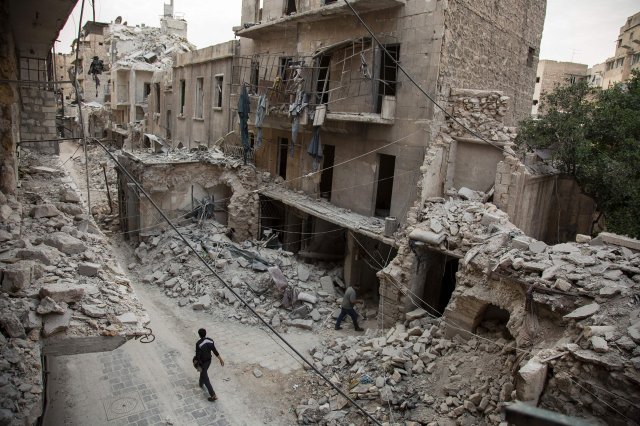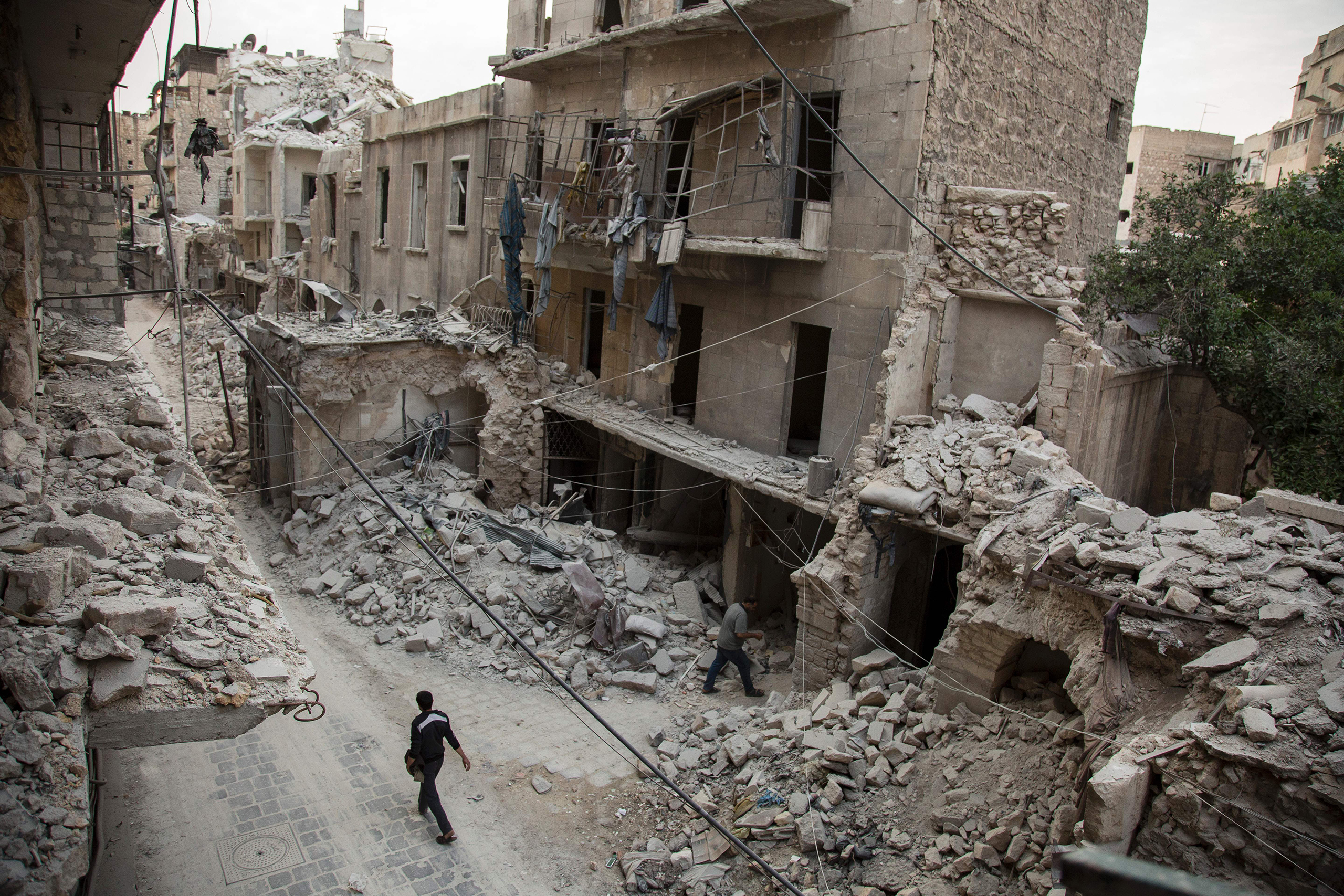War Through Syrian Eyes
In their own words, Syrian photographers reflect on the images that moved them most
By Andrew Katz
A free press is the first casualty of war. Independent national outlets are overrun, threatened or shuttered. Foreign journalists are barred from entry, kidnapped or executed. Local journalists who remain to bear witness in turn bear the brunt. We have seen this and more in Syria.
According to the Committee to Protect Journalists, of the at least 101 journalists who have been killed there since 2011, 88% were local and 27% were classified as photographers. Many others have been intimidated, abducted, maimed or forced into exile. Foreigners who venture in stick to the Kurdish-controlled territory in the north or are allowed access to government-controlled areas. But the majority of pictures that emerge, especially in opposition-held areas, are from Syrians themselves. Activist media networks tweet pictures of the latest carnage, hoping to reach change-makers. Doctors and nurses send reporters unpublishable images of the latest tragedies to unravel in their emergency rooms using tools like WhatsApp. And much of the imagery that appears in online news, in print and on television is shot by local stringers with international agencies, some working under pseudonyms due to safety concerns. They are the last-ditch effort for independent eyes and ears on the ground.
Here, nine Syrian photographers share an image of theirs that moved them most. In their own words—lightly edited for clarity and brevity—they describe the context and personal significance of each picture.
One image shows the dusty chaos after an airstrike. Another shows a rescuer with the Syrian Civil Defense, known as the White Helmets, working to free a man trapped in the rubble. His blood-covered face is directed toward the camera. Another image illustrates the eerie calm of playtime during a brief truce. Viewed separately, they offer a glimpse at daily life in pockets of this war. Taken together, they speak to the tragedies that unfold every day, the heroism that emerges, the humanity that somehow remains.
Warning: Some of the following images are graphic in nature and might be disturbing to some viewers
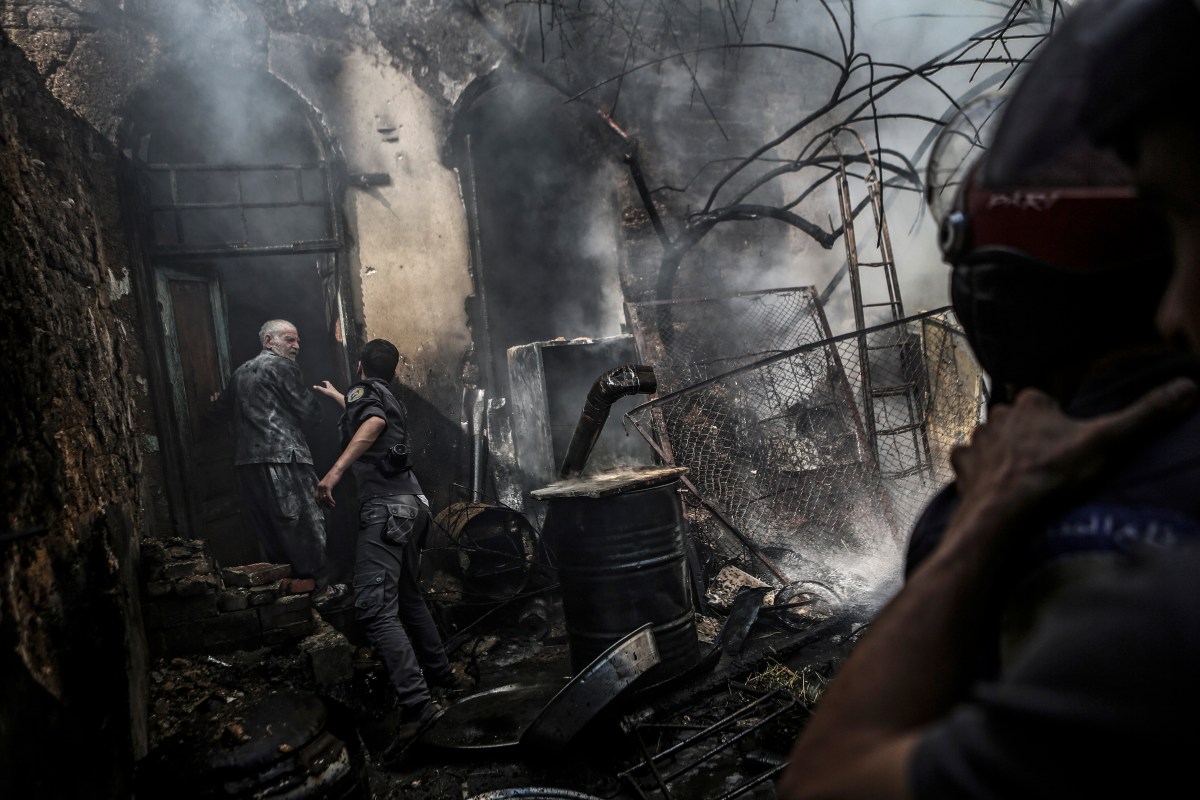
Mohammed Badra
I heard the first sound of the rockets and ran to hide inside the basement. I felt every second go on. I heard voices of screaming women and children, people needing help. I heard my heartbeats and my breathing. Finally, the noise of the explosion of the cluster bombs. I carried my camera and went to figure what happened. My neighbor, Abu Soubhi, has an old house that got burned.
First, I went there and stood in a safe place. I watched Abu Soubhi. He was trying to extinguish the fire inside his home by a cup of water. Our neighbors came and started yelling, “we need civil defense, we need them.” Suddenly, an ambulance came to find injured people. We asked them to call the firemen.
Abu Soubhi started to look deeply in his house while it was burning. Then a tragedy happened in front of me: he started to extinguish the fire with a cup of water, pouring cup after cup. He maybe knew that he couldn’t extinguish the fire, but maybe his love for his house made him try and try. Then the firefighters arrived and started their job. The workers asked him several times to leave his house while it was burning. Every time they asked him, he would just shake his head.
The firefighters carried the hose and focused on a room full of fire. They extinguished it from the yard. There was so much smoke around us, the firefighters didn’t enter the burnt room, but suddenly Abu Soubhi went to enter this room. They asked him not to go in. They asked him so much! But Abu Soubhi didn’t listen at all. He was attached to his land and his house.

Sameer Al-Doumy
This photo shows children playing happily on swings on Feb. 27, 2016, which was the first day of ceasefire in Syria. It was the first day where we didn’t hear the usual sounds of shelling and bombing, we haven’t seen blood and bombardment.
After months of continuous shelling, massacres and siege, and after seeing tens of dead children and injured people due to airstrikes, and after a bloody day that the city had witnessed in which a whole family was killed—a mother and her three children—I didn’t imagine I would see children’s faces with a smile again. I felt so happy that day.

Delil Souleiman
A Kurdish woman in Qamishli, a Kurdish-majority city in Syria’s northeastern Hasakeh province, mourns during the funeral of her brother, who was killed by an Islamic State suicide bomber. I stood there for more than half an hour looking at her face, in which I saw a sadness that I’ve never seen before during my photographic career. She was looking towards the sky, as if complaining to God about this pain.
Whenever I look at it I feel great sadness.

Karam al-Masri
I took this picture in April after Syrian government forces shelled the Al-Quds hospital in the Sukkari neighborhood of Aleppo. This kid lost a number of his family members on that day—his mother and younger brother—and his father had died a couple months before. The boy was crying next to the body of his brother, after he was unable to identify his mother’s disfigured body. His intense crying reminded me of myself when I lost family members about three years ago in government airstrikes.
The boy later recognized his mother through the golden jewelry she was wearing. He then completely collapsed and sat beside her body on the ground, crying and saying “I have no one left except God to take care of me! Who will feed me now? Where will I go? How will I live?”
I can’t forget these words. This is one of the most heart-wrecking scenes for me. I couldn’t continue taking pictures as he was crying next to his mother’s body. Tears started filling my eyes as I remembered myself, how I was standing next to the body of my own mother. The only difference between us being that he is still a young child and cannot rely on himself, while I was 22.

Baraa Al-Halabi
One day the market where Abu Adel works was hit by a barrel bomb. He is married with four daughters and lives in the rebel-held neighborhood of Sukkari in Aleppo, where he works as a fruit vendor to earn a living and feed his children. He lost his cart full of cherries.
He sat next to it and was shocked to see what had happened and that he had escaped death. When I see the photo, I feel sad that such an old man doesn’t have children to help him earn a living. I feel sad how people are dying and that there is no human value left, as they become merely documented numbers.
I loved the photo because I found him again on a different occasion, selling vegetables in the neighborhood with his fixed cart. After all that he went through, life went on.

Ameer Alhalbi
I was with my friends driving in a car when suddenly the first barrel bomb was dropped on us by the Syrian government’s planes. It was 50 meters away. We got to the spot and there were many injured people. The ambulances hadn’t arrived yet. My friend, who was driving, gave aid to a person in his car and took him to the hospital. I remained with my other friend to document the massacre. Three minutes later the first ambulance arrived, and as they put an injured person on a stretcher, we heard the second barrel bomb falling from the air, onto the same place as the previous one. It was only a few meters away. The injured person was alive, but died from that second barrel bomb. A paramedic was also seriously injured as he was trying to help the others. Most of those injured on the street died and it was only by luck that my friend, who volunteers with the Syrian Civil Defense, and myself escaped death.
It was a terrifying scene. Tens of dead bodies were lying in front of us and when the second bomb fell the ambulances started arriving with the relatives of the injured, who started looking for their relatives. They were screaming and crying, weeps that were louder than any sound. The smell of death was filling the street, there were many dead people with their limbs cut off, and the Civil Defense volunteers began to deliver first aid. For many days I couldn’t clear my mind from the image of how the injured had died as the second barrel bomb fell on them, and what the street looked like as it was filled with dead bodies, and how the paramedic who was there to treat people had been treated by them in the end.
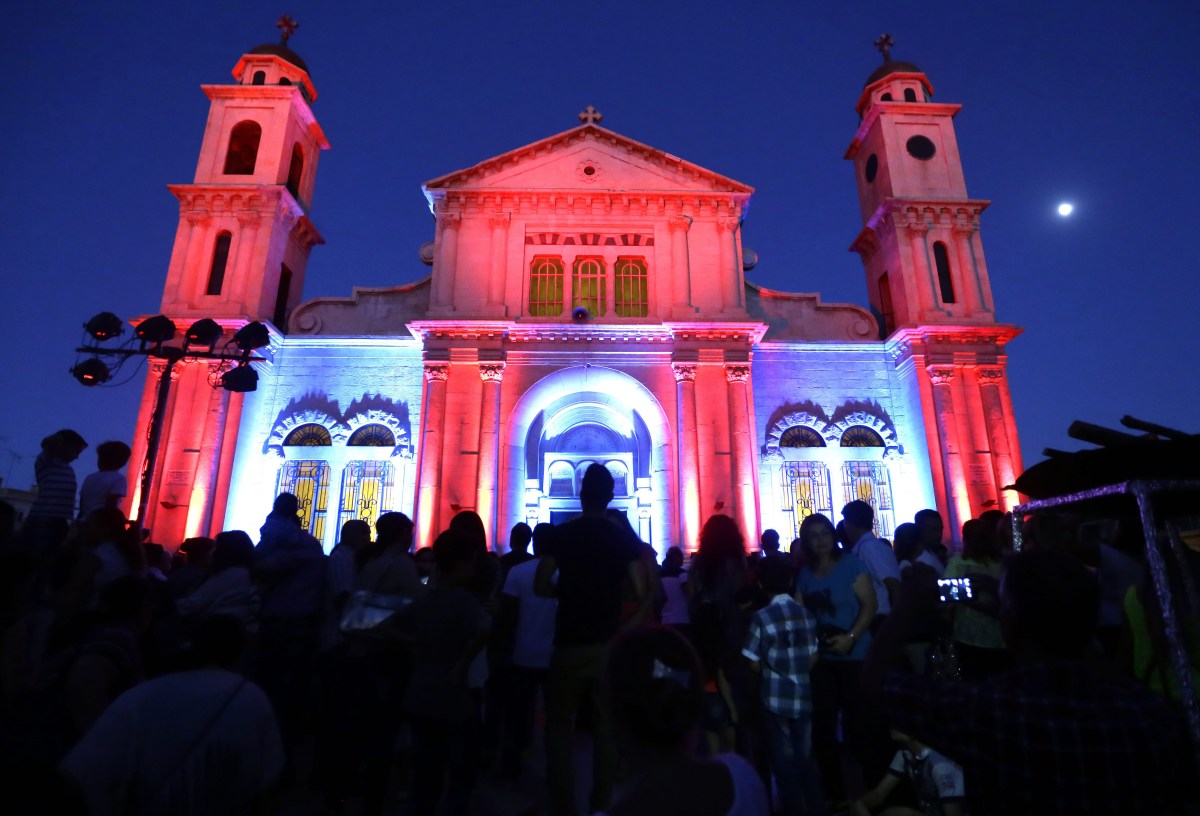
Louai Beshara
I consider this picture proof that Syrians still have hope that this conflict will end, and that many Syrian Christians are holding on to their country. I took this picture, showing the backs of the people as they look towards the church being lit by colors, to express their clinging to their church and their country.
I got married in this church and have celebrated family occasions in it. This church is located close to the frontline in the area of Jobar, in Eastern Ghouta, so this has led fewer people to go because of the missiles and bullets. This year, as every year, Christians have celebrated the feast of the Holy Cross, but what was different this year was the big number of people who came to pray and stayed till after the mass even though it was in the evening hours, which is considered late to those who live in the neighboring Damascus suburbs and have no means of transport.
The picture represents the hope that Syria will one day go back to what it used to be.
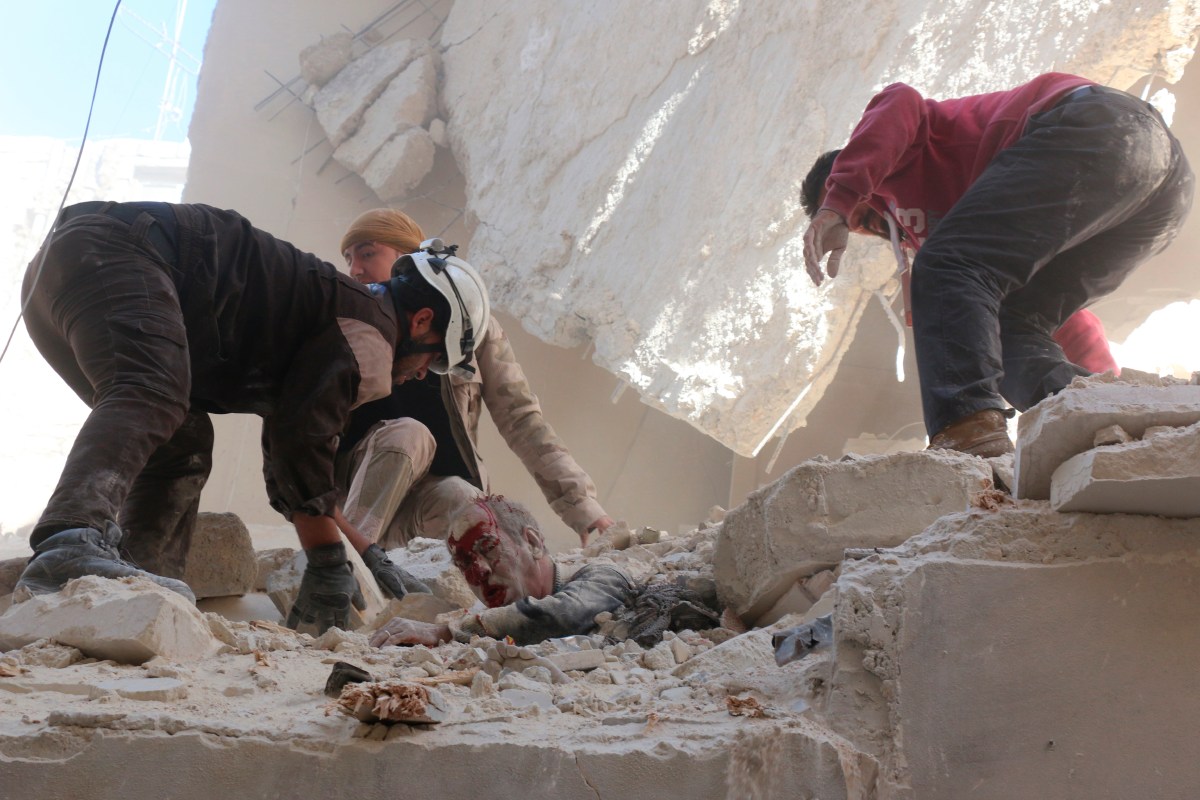
Thaer Mohammed
When I saw this old man and his face covered in blood, mixed with the dust of his house, looking at me, I imagined the man was telling me “make your lens the witness to this crime that has been committed against us!” His facial expressions affected me very much and every time I would take a picture of him, I would imagine myself in his place, being a survivor, not knowing what the fate of the rest of my family members is, as he was the only one whose head was seen amid the rubble and dust. Other times I’ve imagined him to be one of my family members and I’m documenting the damned crime committed against him. Whenever he’d look at me, I could see in his eyes the pain that women, children and men of this nation have suffered, and images of victims of violence in Syria would flash before my eyes.

Beha el Halebi
One day I heard that the Sukkari neighborhood of Aleppo was under a heavy attack. I got on my motorbike and rode down to Sukkari immediately. I saw causalities when I got there. There was panic and women and children running in fear. Among the dust cloud I saw a child was running away from the area and I took a picture of him.
People were screaming for help and I was scared, too. The regime was attacking the same areas again so I finished my work early and left the shelled area. I sent the images to the agency. I have experienced this kind of massacre before, so I can still hear the voices of people screaming inside my head. Being a journalist in the world’s most dangerous city is a very difficult job to do. We risk our lives to make the world hear the systematic killing by Assad’s regime against civilians. It is like screaming for help in a deep well where no one can hear you.
Can anybody hear us?
